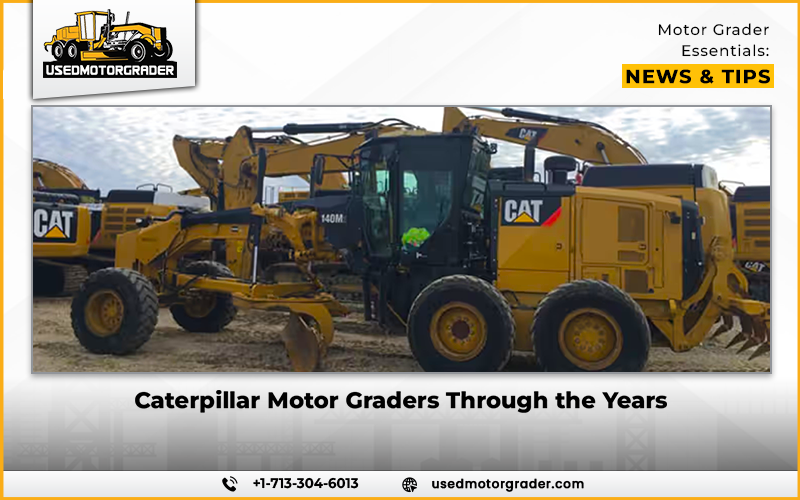There are only a several reputable brands in the heavy equipment industry that have a profound impact. Caterpillar construction equipment is one of them. The company has decoded some secret market techniques to stay on top even after a century.
How many companies or brands can you name that have spent a century and continue to produce state-of-the-art products? Hardly a few! It is not easy to stay relevant for centuries.
Particularly, when it comes to the motor grader brand, the company has come a long way. For over a century, the Caterpillar motor grader has been known for its durability, powerful grading, and innovation.
The evolution of caterpillar heavy equipment, especially the caterpillar motor grader, shows continuous advancement. Over time, the company has evolved the machinery according to the project type and its advancement.
From humble horse-drawn beginnings to today’s technologically advanced graders. Caterpillar’s story is one of constant innovation and responding to the challenges of building better, longer-lasting roads.
The Early Days: Russell’s Vision
Richard Russell and Charles Stockland, who were employed in the tiny Minnesota town of Stephen, constructed the first horse-drawn elevating grader in 1903. Yes! The story began way back in 1903, marking the beginning of Caterpillar’s entry into the motor grader market.
From that beginning, the company never looked back. That collaboration gave rise to the Russell Grader Company, a business that would soon have a significant impact on the history of road machinery.
The first-of-its-kind invention that foreshadowed the future of mechanized road construction was Richard Russell’s patent for the elevating grader, which was driven by a gas engine to move its conveyor..
On the initial basis, Russel introduced the simplx, a small blade for leveling and surfacing. The blade turned out to be so effective and useful for these tasks. So, it quickly became popular in the market and noticeable to contractors and municipal officers.
Over time, more blade grader models were added, firming the corporation’s position in the early road machinery market.
The Move Toward Motorization
Just after seven years, the company witnessed a major advancement. The year 1910 was the turning point for the caterpillar and the whole construction market. Russel and the team were ready to meet the challenge. In 1919, they began work on an early version of the motor grader.
The clear vision, persistence, and continued work provide the desirable results. They engineered the “Motor Patrol,” released in 1920, which used an Allis-Chalmers tractor as its base, with a grader frame built around it.
Russell made a major breakthrough in 1926 when they unveiled their first motor patrol, which included a Caterpillar track-type tractor.
This combination was more than just practical; it hinted at the close cooperation that Russell and Caterpillar would soon have.
Caterpillar Steps In: The Acquisition
Blade graders were usually mounted on Caterpillar tractors working in the 1920s. Both executives recognized an opportunity to merge their strengths.
On December 4, 1928, Caterpillar Tractor Co. purchased the Russell Grader Manufacturing Company. This purchase created the new “Road Machinery Division” of Caterpillar, intending to produce blade graders and construct motor graders.
This large acquisition enabled Caterpillar to offer an entire grading line, marrying their heavy tractors with Russell’s unique grader designs. It also began a long tradition of motor graders manufactured for particular applications.
The Auto Patrol: An Innovation in 1931
In April 1931, Caterpillar introduced the Auto Patrol, which established the company as a leader in grading. The Auto Patrol was brand new in design, as opposed to previous motor patrols. Those were little more than tractors with grader frames attached.
The new style was far more efficient and controllable, and became the new standard within the industry. The success of the Auto Patrol was not only in improved engineering, but in understanding the evolving needs of large-scale road construction.
At that time, when automobile travel and roads were multiplying by the hour. Caterpillar established itself as the manufacturer of choice for reliable grading products.
Expansion and Global Reach
Caterpillar kept innovating over the years, adding includes that increased machine longevity, operator support, and quality.
In order to fulfill the rising demand worldwide, their production also increased.
Currently, Caterpillar produces motor graders at plants in Decatur, Illinois; North Little Rock, Arkansas; Caterpillar Brasil Ltd.; Caterpillar Suzhou Company Ltd.; and Shandong SEM Machinery Co., Ltd.
The Caterpillar motor grader is a reliable option in both developed and emerging economies because of its global production capability, which guarantees that contractors in a variety of markets can access Caterpillar’s technology and support network.
A Legacy That Continues to Shape the Future
The history of the Caterpillar motor grader is not a history of equipment, it’s a history of adapting to new technologies, industries, and demands.
From Richard Russell’s original elevating grader to GPS-equipped machines today, every step is a clear indication of what the construction industry requires.
With the demand for improved infrastructure growing all across the globe, Caterpillar can lead the next motor grader revolution.
It will construct roads quickly, have them last longer, and be of higher quality. With more than a century of history behind it and a dedication to improving every day, the Caterpillar motor grader remains the pillar of contemporary construction.


